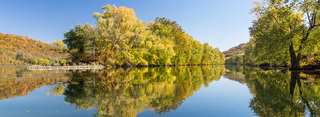 | Back to e-WV
| Back to e-WV
 The West Virginia Encyclopedia
The West Virginia Encyclopedia
 | Back to e-WV
| Back to e-WV
 The West Virginia Encyclopedia
The West Virginia Encyclopedia

The Ohio River Islands National Wildlife Refuge protects habitat for wildlife in one of America’s busiest waterways. The refuge was established in 1990 when the U.S. Fish & Wildlife Service, with the assistance of the Nature Conservancy, purchased eight islands. The refuge now encompasses 3,440 acres and includes 22 islands and four pieces of shoreline along 362 miles of the Ohio River. Seventeen of the refuge’s 21 islands lie within West Virginia, while two are in Pennsylvania and two in Kentucky. Long-range plans call for the purchase of additional islands for a total of 38.
Before receiving federal protection, some of the islands had been used for farming, oil and gas extraction, sand and gravel mining, and other uses. Over time, however, the hardwood forests have returned, providing habitat for the abundant wildlife. The islands provide vital feeding and resting habitat for many birds during spring and fall migration. Two hundred species of birds use the refuge during the year, including bald eagles, great blue herons, osprey, and prothonotary warblers. Other wildlife, from rare tiger beetles to common white-tailed deer, also inhabit this floodplain refuge.
The refuge is home to more than 40 species of freshwater mussels, including the federally endangered fanshell and pink mucket. The refuge staff monitors the spread of the zebra mussel, an invasive species that entered the Ohio River system in the early 1990s.
As part of the national wildlife refuge system, the Ohio River islands are managed under a ‘‘wildlife first’’ mission, but visitors are welcome. Refuge properties are open daily from sunrise until sunset. Although most of the islands are accessible only by boat, the 240-acre Middle Island at St. Marys offers bridge access, with a self-guided auto tour, a wildlife viewing blind, and a nature trail on the island. The refuge encourages wildlife-dependent recreation including wildlife observation and photography, fishing, and hunting. Special events with an environmental education emphasis take place primarily during the summer months. The refuge’s visitors center, located near Williamstown, features an aquarium and other exhibits.
Written by Janet Butler